Hui Yu
Double Banking on Knowledge: Customized Modulation and Prototypes for Multi-Modality Semi-supervised Medical Image Segmentation
Oct 23, 2024



Abstract:Multi-modality (MM) semi-supervised learning (SSL) based medical image segmentation has recently gained increasing attention for its ability to utilize MM data and reduce reliance on labeled images. However, current methods face several challenges: (1) Complex network designs hinder scalability to scenarios with more than two modalities. (2) Focusing solely on modality-invariant representation while neglecting modality-specific features, leads to incomplete MM learning. (3) Leveraging unlabeled data with generative methods can be unreliable for SSL. To address these problems, we propose Double Bank Dual Consistency (DBDC), a novel MM-SSL approach for medical image segmentation. To address challenge (1), we propose a modality all-in-one segmentation network that accommodates data from any number of modalities, removing the limitation on modality count. To address challenge (2), we design two learnable plug-in banks, Modality-Level Modulation bank (MLMB) and Modality-Level Prototype (MLPB) bank, to capture both modality-invariant and modality-specific knowledge. These banks are updated using our proposed Modality Prototype Contrastive Learning (MPCL). Additionally, we design Modality Adaptive Weighting (MAW) to dynamically adjust learning weights for each modality, ensuring balanced MM learning as different modalities learn at different rates. Finally, to address challenge (3), we introduce a Dual Consistency (DC) strategy that enforces consistency at both the image and feature levels without relying on generative methods. We evaluate our method on a 2-to-4 modality segmentation task using three open-source datasets, and extensive experiments show that our method outperforms state-of-the-art approaches.
UWStereo: A Large Synthetic Dataset for Underwater Stereo Matching
Sep 03, 2024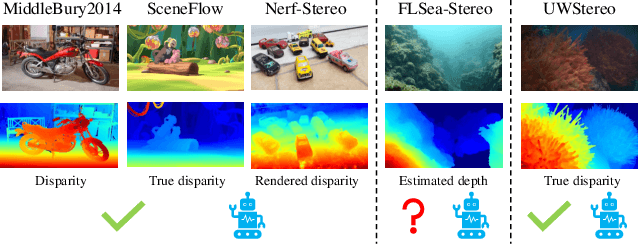
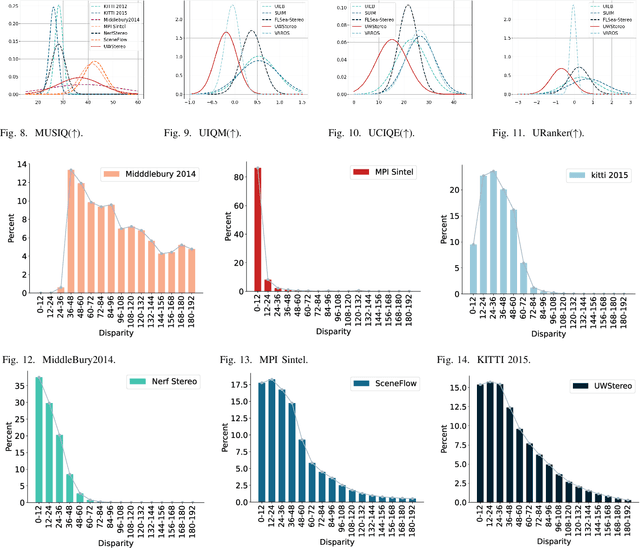
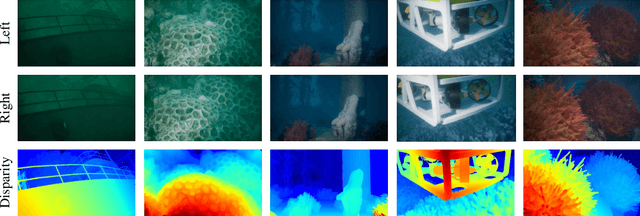
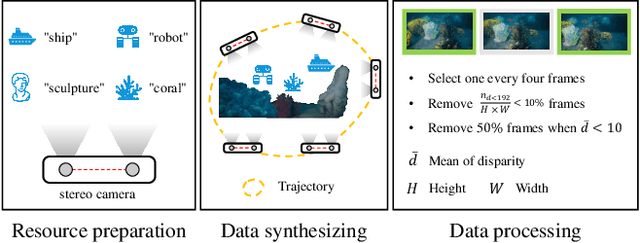
Abstract:Despite recent advances in stereo matching, the extension to intricate underwater settings remains unexplored, primarily owing to: 1) the reduced visibility, low contrast, and other adverse effects of underwater images; 2) the difficulty in obtaining ground truth data for training deep learning models, i.e. simultaneously capturing an image and estimating its corresponding pixel-wise depth information in underwater environments. To enable further advance in underwater stereo matching, we introduce a large synthetic dataset called UWStereo. Our dataset includes 29,568 synthetic stereo image pairs with dense and accurate disparity annotations for left view. We design four distinct underwater scenes filled with diverse objects such as corals, ships and robots. We also induce additional variations in camera model, lighting, and environmental effects. In comparison with existing underwater datasets, UWStereo is superior in terms of scale, variation, annotation, and photo-realistic image quality. To substantiate the efficacy of the UWStereo dataset, we undertake a comprehensive evaluation compared with nine state-of-the-art algorithms as benchmarks. The results indicate that current models still struggle to generalize to new domains. Hence, we design a new strategy that learns to reconstruct cross domain masked images before stereo matching training and integrate a cross view attention enhancement module that aggregates long-range content information to enhance the generalization ability.
Boosting Spatial-Spectral Masked Auto-Encoder Through Mining Redundant Spectra for HSI-SAR/LiDAR Classification
Jun 03, 2024Abstract:Although recent masked image modeling (MIM)-based HSI-LiDAR/SAR classification methods have gradually recognized the importance of the spectral information, they have not adequately addressed the redundancy among different spectra, resulting in information leakage during the pretraining stage. This issue directly impairs the representation ability of the model. To tackle the problem, we propose a new strategy, named Mining Redundant Spectra (MRS). Unlike randomly masking spectral bands, MRS selectively masks them by similarity to increase the reconstruction difficulty. Specifically, a random spectral band is chosen during pretraining, and the selected and highly similar bands are masked. Experimental results demonstrate that employing the MRS strategy during the pretraining stage effectively improves the accuracy of existing MIM-based methods on the Berlin and Houston 2018 datasets.
High-order Neighborhoods Know More: HyperGraph Learning Meets Source-free Unsupervised Domain Adaptation
May 11, 2024
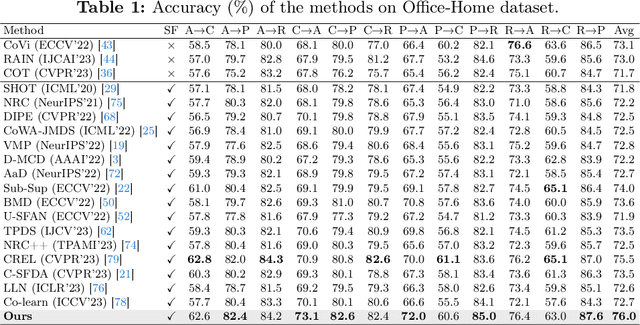
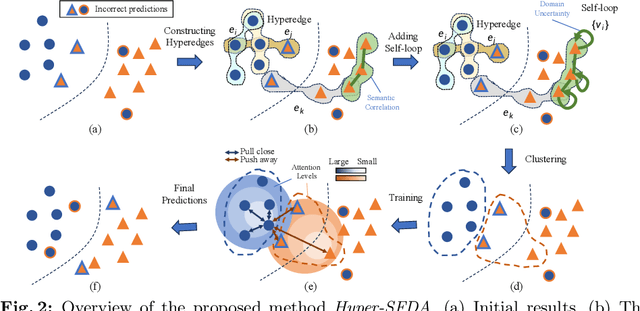
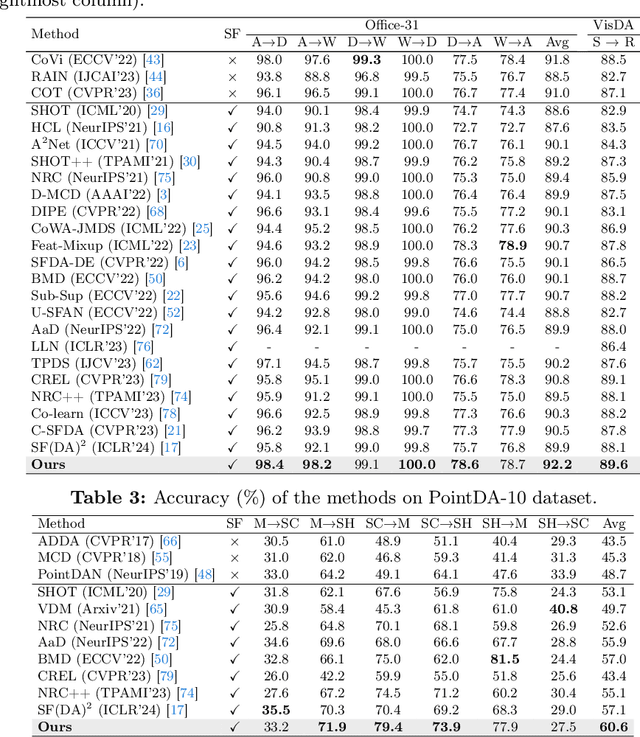
Abstract:Source-free Unsupervised Domain Adaptation (SFDA) aims to classify target samples by only accessing a pre-trained source model and unlabelled target samples. Since no source data is available, transferring the knowledge from the source domain to the target domain is challenging. Existing methods normally exploit the pair-wise relation among target samples and attempt to discover their correlations by clustering these samples based on semantic features. The drawback of these methods includes: 1) the pair-wise relation is limited to exposing the underlying correlations of two more samples, hindering the exploration of the structural information embedded in the target domain; 2) the clustering process only relies on the semantic feature, while overlooking the critical effect of domain shift, i.e., the distribution differences between the source and target domains. To address these issues, we propose a new SFDA method that exploits the high-order neighborhood relation and explicitly takes the domain shift effect into account. Specifically, we formulate the SFDA as a Hypergraph learning problem and construct hyperedges to explore the local group and context information among multiple samples. Moreover, we integrate a self-loop strategy into the constructed hypergraph to elegantly introduce the domain uncertainty of each sample. By clustering these samples based on hyperedges, both the semantic feature and domain shift effects are considered. We then describe an adaptive relation-based objective to tune the model with soft attention levels for all samples. Extensive experiments are conducted on Office-31, Office-Home, VisDA, and PointDA-10 datasets. The results demonstrate the superiority of our method over state-of-the-art counterparts.
Plaintext-Free Deep Learning for Privacy-Preserving Medical Image Analysis via Frequency Information Embedding
Mar 25, 2024
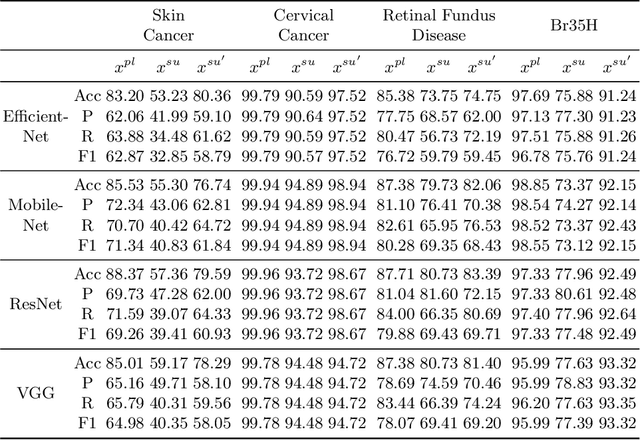
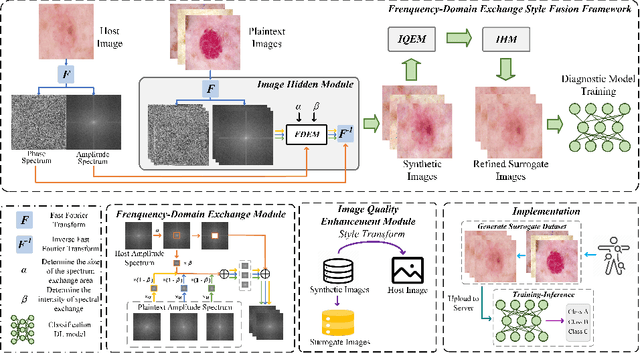

Abstract:In the fast-evolving field of medical image analysis, Deep Learning (DL)-based methods have achieved tremendous success. However, these methods require plaintext data for training and inference stages, raising privacy concerns, especially in the sensitive area of medical data. To tackle these concerns, this paper proposes a novel framework that uses surrogate images for analysis, eliminating the need for plaintext images. This approach is called Frequency-domain Exchange Style Fusion (FESF). The framework includes two main components: Image Hidden Module (IHM) and Image Quality Enhancement Module~(IQEM). The~IHM performs in the frequency domain, blending the features of plaintext medical images into host medical images, and then combines this with IQEM to improve and create surrogate images effectively. During the diagnostic model training process, only surrogate images are used, enabling anonymous analysis without any plaintext data during both training and inference stages. Extensive evaluations demonstrate that our framework effectively preserves the privacy of medical images and maintains diagnostic accuracy of DL models at a relatively high level, proving its effectiveness across various datasets and DL-based models.
Attention-Guided Erasing: A Novel Augmentation Method for Enhancing Downstream Breast Density Classification
Jan 08, 2024Abstract:The assessment of breast density is crucial in the context of breast cancer screening, especially in populations with a higher percentage of dense breast tissues. This study introduces a novel data augmentation technique termed Attention-Guided Erasing (AGE), devised to enhance the downstream classification of four distinct breast density categories in mammography following the BI-RADS recommendation in the Vietnamese cohort. The proposed method integrates supplementary information during transfer learning, utilizing visual attention maps derived from a vision transformer backbone trained using the self-supervised DINO method. These maps are utilized to erase background regions in the mammogram images, unveiling only the potential areas of dense breast tissues to the network. Through the incorporation of AGE during transfer learning with varying random probabilities, we consistently surpass classification performance compared to scenarios without AGE and the traditional random erasing transformation. We validate our methodology using the publicly available VinDr-Mammo dataset. Specifically, we attain a mean F1-score of 0.5910, outperforming values of 0.5594 and 0.5691 corresponding to scenarios without AGE and with random erasing (RE), respectively. This superiority is further substantiated by t-tests, revealing a p-value of p<0.0001, underscoring the statistical significance of our approach.
DomainForensics: Exposing Face Forgery across Domains via Bi-directional Adaptation
Dec 17, 2023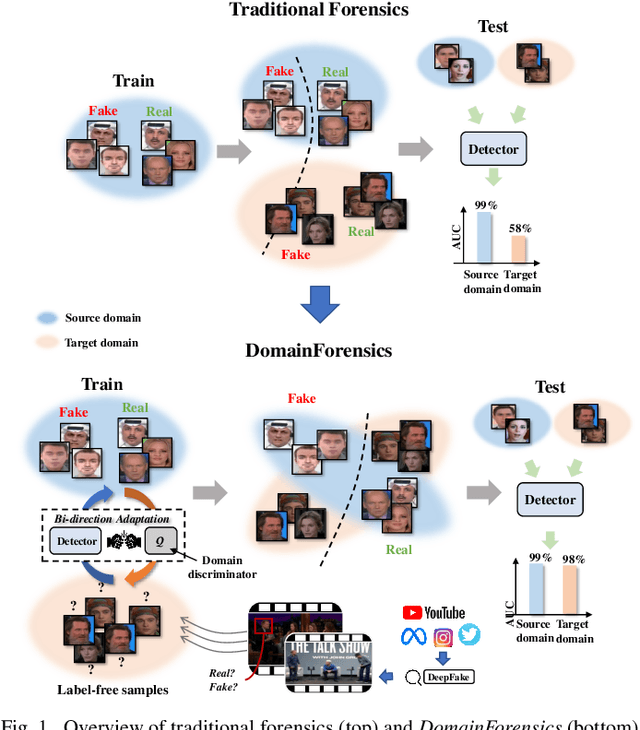
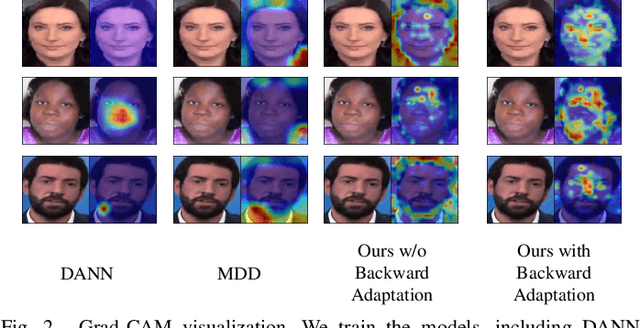
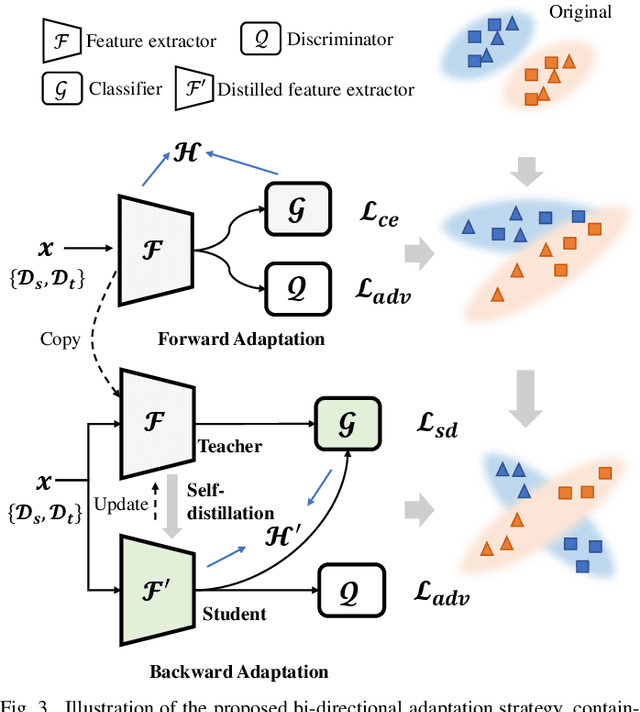
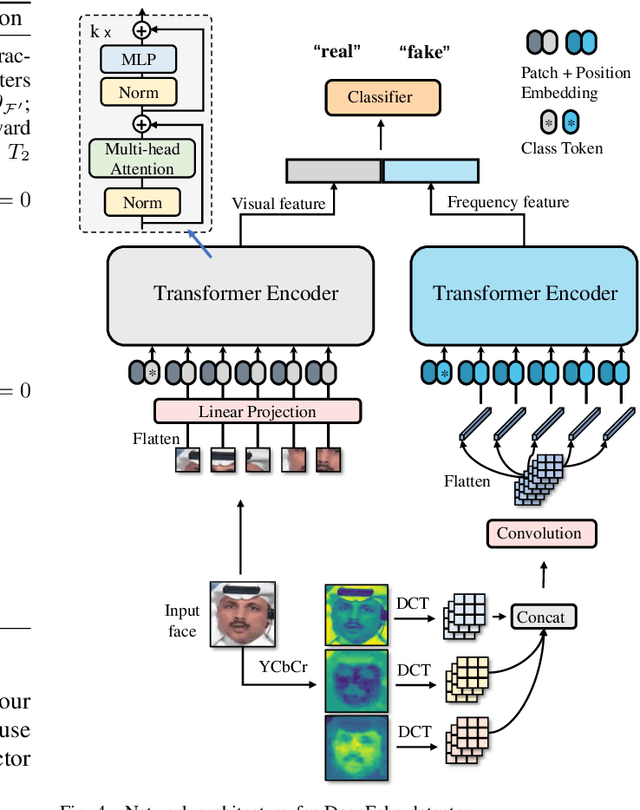
Abstract:Recent DeepFake detection methods have shown excellent performance on public datasets but are significantly degraded on new forgeries. Solving this problem is important, as new forgeries emerge daily with the continuously evolving generative techniques. Many efforts have been made for this issue by seeking the commonly existing traces empirically on data level. In this paper, we rethink this problem and propose a new solution from the unsupervised domain adaptation perspective. Our solution, called DomainForensics, aims to transfer the forgery knowledge from known forgeries to new forgeries. Unlike recent efforts, our solution does not focus on data view but on learning strategies of DeepFake detectors to capture the knowledge of new forgeries through the alignment of domain discrepancies. In particular, unlike the general domain adaptation methods which consider the knowledge transfer in the semantic class category, thus having limited application, our approach captures the subtle forgery traces. We describe a new bi-directional adaptation strategy dedicated to capturing the forgery knowledge across domains. Specifically, our strategy considers both forward and backward adaptation, to transfer the forgery knowledge from the source domain to the target domain in forward adaptation and then reverse the adaptation from the target domain to the source domain in backward adaptation. In forward adaptation, we perform supervised training for the DeepFake detector in the source domain and jointly employ adversarial feature adaptation to transfer the ability to detect manipulated faces from known forgeries to new forgeries. In backward adaptation, we further improve the knowledge transfer by coupling adversarial adaptation with self-distillation on new forgeries. This enables the detector to expose new forgery features from unlabeled data and avoid forgetting the known knowledge of known...
Energizing Federated Learning via Filter-Aware Attention
Nov 18, 2023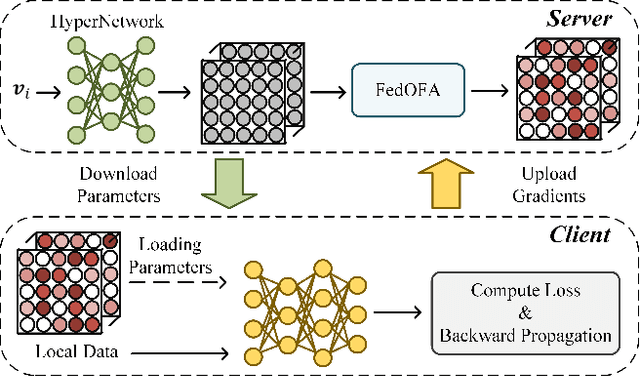
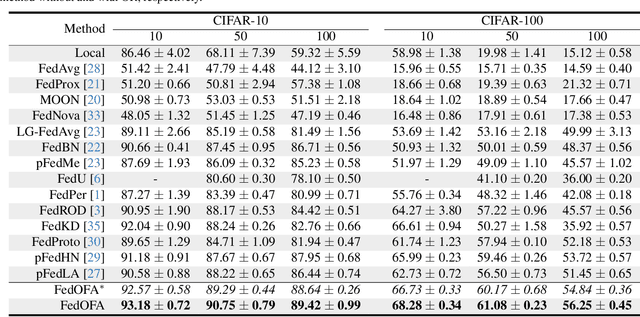

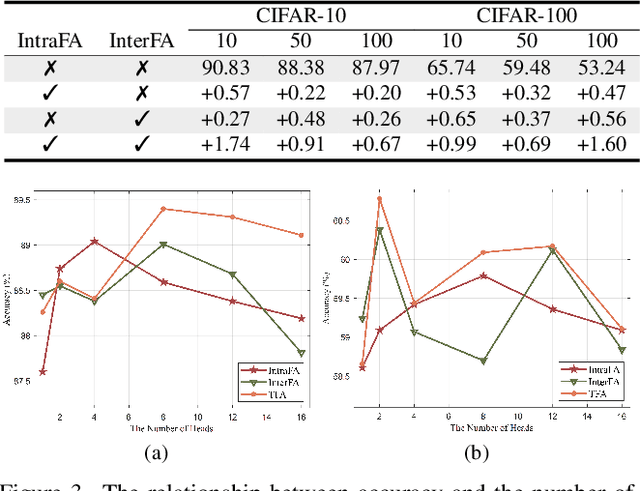
Abstract:Federated learning (FL) is a promising distributed paradigm, eliminating the need for data sharing but facing challenges from data heterogeneity. Personalized parameter generation through a hypernetwork proves effective, yet existing methods fail to personalize local model structures. This leads to redundant parameters struggling to adapt to diverse data distributions. To address these limitations, we propose FedOFA, utilizing personalized orthogonal filter attention for parameter recalibration. The core is the Two-stream Filter-aware Attention (TFA) module, meticulously designed to extract personalized filter-aware attention maps, incorporating Intra-Filter Attention (IntraFa) and Inter-Filter Attention (InterFA) streams. These streams enhance representation capability and explore optimal implicit structures for local models. Orthogonal regularization minimizes redundancy by averting inter-correlation between filters. Furthermore, we introduce an Attention-Guided Pruning Strategy (AGPS) for communication efficiency. AGPS selectively retains crucial neurons while masking redundant ones, reducing communication costs without performance sacrifice. Importantly, FedOFA operates on the server side, incurring no additional computational cost on the client, making it advantageous in communication-constrained scenarios. Extensive experiments validate superior performance over state-of-the-art approaches, with code availability upon paper acceptance.
Privacy-Preserving Encrypted Low-Dose CT Denoising
Oct 13, 2023


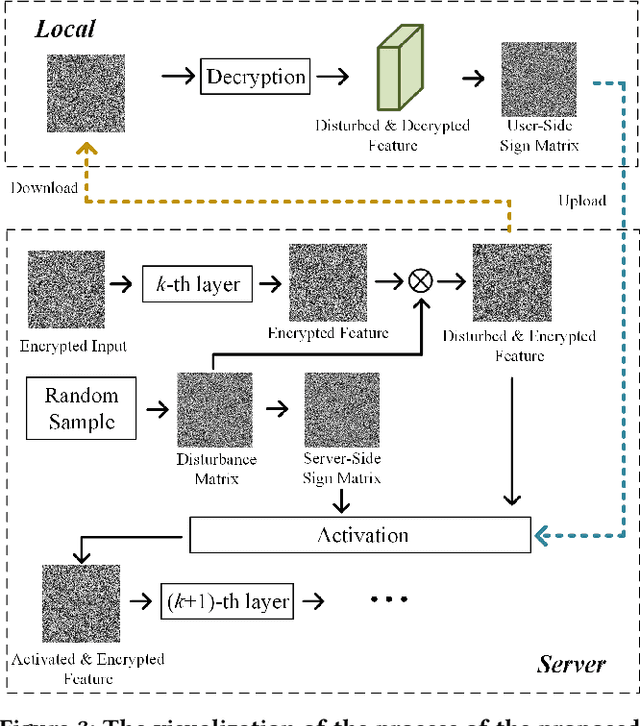
Abstract:Deep learning (DL) has made significant advancements in tomographic imaging, particularly in low-dose computed tomography (LDCT) denoising. A recent trend involves servers training powerful models with large amounts of self-collected private data and providing application programming interfaces (APIs) for users, such as Chat-GPT. To avoid model leakage, users are required to upload their data to the server model, but this way raises public concerns about the potential risk of privacy disclosure, especially for medical data. Hence, to alleviate related concerns, in this paper, we propose to directly denoise LDCT in the encrypted domain to achieve privacy-preserving cloud services without exposing private data to the server. To this end, we employ homomorphic encryption to encrypt private LDCT data, which is then transferred to the server model trained with plaintext LDCT for further denoising. However, since traditional operations, such as convolution and linear transformation, in DL methods cannot be directly used in the encrypted domain, we transform the fundamental mathematic operations in the plaintext domain into the operations in the encrypted domain. In addition, we present two interactive frameworks for linear and nonlinear models in this paper, both of which can achieve lossless operating. In this way, the proposed methods can achieve two merits, the data privacy is well protected and the server model is free from the risk of model leakage. Moreover, we provide theoretical proof to validate the lossless property of our framework. Finally, experiments were conducted to demonstrate that the transferred contents are well protected and cannot be reconstructed. The code will be released once the paper is accepted.
Curvature-based Transformer for Molecular Property Prediction
Jul 25, 2023Abstract:The prediction of molecular properties is one of the most important and challenging tasks in the field of artificial intelligence-based drug design. Among the current mainstream methods, the most commonly used feature representation for training DNN models is based on SMILES and molecular graphs, although these methods are concise and effective, they also limit the ability to capture spatial information. In this work, we propose Curvature-based Transformer to improve the ability of Graph Transformer neural network models to extract structural information on molecular graph data by introducing Discretization of Ricci Curvature. To embed the curvature in the model, we add the curvature information of the graph as positional Encoding to the node features during the attention-score calculation. This method can introduce curvature information from graph data without changing the original network architecture, and it has the potential to be extended to other models. We performed experiments on chemical molecular datasets including PCQM4M-LST, MoleculeNet and compared with models such as Uni-Mol, Graphormer, and the results show that this method can achieve the state-of-the-art results. It is proved that the discretized Ricci curvature also reflects the structural and functional relationship while describing the local geometry of the graph molecular data.
 Add to Chrome
Add to Chrome Add to Firefox
Add to Firefox Add to Edge
Add to Edge